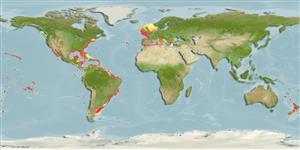Common names from other countries
Environment: milieu / climate zone / depth range / distribution range
Ecología
; salobre; rango de profundidad 0 - 220 m (Ref. 116114). Tropical
Atlantic, Caribbean and Indo-Pacific Oceans in tropical and subtropical climates.
Length at first maturity / Tamaño / Peso / Age
Maturity: Lm ? range ? - ? cm Max length : 0.5 cm WD macho / no sexado; (Ref. 2992)
Epipelagic (Ref. 116114). Known from mangroves (Ref. 86642). Found in patch reefs, mangrove island, sand trough areas, outer ridge and fore-reef slope on substrates composed of algae, mangrove roots or dead corals and gorgonians. In Belize, it is found at depths of 0.2 to 31 m. As with other hydroids, this species exhibits a pelagic medusoid stage.
Life cycle and mating behavior
Madurez | Reproducción | Puesta | Huevos | Fecundidad | Larva
Species exhibits both asexual and sexual reproduction by budding during hydroid stage and release of gametes in medusae stages (Ref. 1663, p. 15). Period of reproductive maturity recorded for Carrie Bow Cay, Belize is from 17th to 25th May, during which the samples collected had gonophores or medusa buds
Migotto, A.E., A.C. Marques, A.C. Morandini and F.L. da Silveira. 2002. (Ref. 813)
IUCN Red List Status (Ref. 130435)
CITES status (Ref. 108899)
Not Evaluated
Not Evaluated
Human uses
| FishSource |
Herramientas
Más información
Age/SizeCrecimientoLength-weightLength-lengthMorfologíaLarvaAbundancia
Fuentes de Internet
Estimates based on models
Preferred temperature
(Ref.
115969): 11.5 - 28, mean 23.1 (based on 2116 cells).
Vulnerability
Low vulnerability (10 of 100).
Price category
Unknown.
